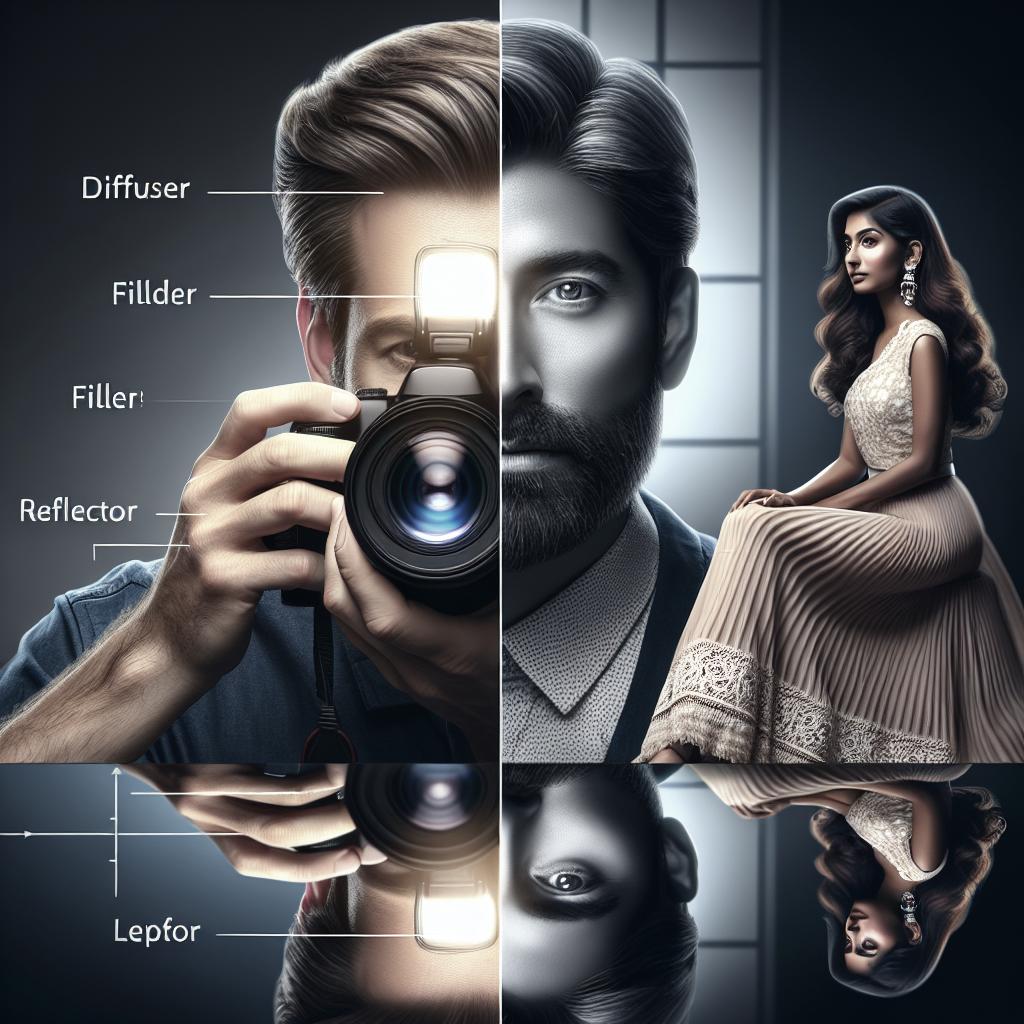“`html
Portrait photography is an art form that captures the personality, mood, and essence of a person through the lens of a camera. It is both challenging and rewarding, requiring technical skills and a deep understanding of human emotions. Whether you’re a budding photographer looking to improve your portrait skills or an enthusiast keen on capturing your friends and family in the best light, this guide provides practical tips and insights to elevate your portrait photography. Covering everything from technical knowledge to fostering a comfortable environment for your subjects, this comprehensive guide outlines 15 essential tips for capturing stunning portraits. Additionally, the guide addresses frequently asked questions about portrait photography, helping you navigate this fascinating field with confidence.
What is Portrait Photography?
Portrait photography focuses on capturing the likeness, personality, and even the mood of a person or group of people. Unlike other photography styles, portrait photography aims to utilize lighting, backdrops, and posing to create creative and compelling images that tell a story about the subject. From school photos to professional headshots, portraits come in varying styles and purposes, but they all share a common goal: highlighting the essence of the individual in front of the camera.
This genre can be divided into various subcategories like traditional portraiture, environmental portraits, candid portraits, and more. Whether you’re shooting in a studio with controlled lighting or outdoors utilizing natural light, understanding the principles and techniques unique to portrait photography will help you produce striking, memorable images.
Portrait photography tips: How to take good portraits
1. Get to know your subject
One of the most critical aspects of capturing a great portrait is understanding your subject. Spend some time talking to them before the shoot to make them feel comfortable and learn about their personality, interests, and what they want to convey in the portrait. This rapport can help to ease any nervousness and make the session more enjoyable for both parties.
When your subject feels relaxed, their true personality can come through, resulting in more authentic and compelling photographs. Discussing wardrobe choices, background preferences, and possible poses beforehand can also help in setting clear expectations and achieving the desired results.
2. Scout your location
The backdrop and setting of a portrait can add depth and context to your images, so take some time to scout potential locations. Whether you’re planning to shoot indoors or outdoors, find backgrounds that complement your subject and don’t distract from them. Depending on the mood you want to capture, your setting could be a cozy studio, a bustling cityscape, or a serene natural landscape.
Consider the lighting conditions at each location; natural light can be flattering, but also unpredictable. An overcast day can offer soft, diffused lighting, while the golden hour—the period shortly after sunrise or before sunset—provides a warm, natural glow. Understanding how to leverage the lighting at your chosen location is crucial for capturing visually appealing portraits.
3. Know your camera
Familiarity with your camera’s settings is paramount in portrait photography. Understanding how to manually control exposure settings like ISO, aperture, and shutter speed gives you greater creative control. An open aperture (a low f-stop number) can create a shallow depth of field, blurring the background and making your subject stand out.
Using the right focal length is also essential. A portrait lens (usually 50mm to 85mm) will help avoid distortion and keep your subject looking natural. Practicing with these settings before your shoot can make the process smoother and more professional.
4. Keep samples
Having a portfolio of sample shots can serve as a valuable reference for both you and your subject. Before the shoot, review various poses, lighting setups, and angles that have worked well for you in the past. This library of images can be a useful guide and can help your subject understand what you’re aiming to achieve.
Sample images can also be used to inspire new ideas and approaches. By frequently updating your collection and learning from each session, you can continually improve and adapt your techniques to produce the best portraits possible.
5. Mind the eyes
The eyes are often considered the windows to the soul, and this is particularly true in portrait photography. Focusing on the eyes can bring an image to life and establish a connection between the subject and the viewer. Ensure that the eyes are sharp and well-lit, as they will naturally draw attention.
You can use techniques like catchlights—small reflections of light in the subject’s eyes—to add a sparkle and enhance their expression. Ensuring that the eyes are in sharp focus can make even simple portraits more engaging and impactful.
6. Evoke genuine expression
Capturing genuine emotion is one of the hallmarks of a good portrait. Work on creating a comfortable atmosphere where your subject can relax and be themselves. Simple techniques like engaging in casual conversation, playing their favorite music, or telling a good joke can help to bring natural expressions to the surface.
Sometimes giving your subject a task or asking them to think about a particular memory can evoke the emotion you want to capture. Patience is key; waiting for the right moment can often lead to the most poignant and authentic shots.
7. Change angles
Experimenting with different angles can add variety and dynamism to your portraits. Don’t be afraid to move around your subject to find the most flattering perspective. Shooting from above can create a sense of intimacy, while shooting from below can give the subject a more powerful and dominant presence.
Tilting your camera slightly or using a diagonal composition can also add interest to your portraits. The key is to explore different perspectives and not limit yourself to eye-level shots, which can sometimes appear flat and uninspired.
8. Use props
Props can add an extra layer of storytelling to your portraits. Whether it’s something simple like a flower or something more elaborate that aligns with the subject’s interests, props can make portraits more engaging and personalized. Additionally, they can help your subject feel more at ease and provide them with something to interact with during the shoot.
However, it’s important not to let props overshadow your subject. They should complement, not compete with, the main focus of the image. Subtle, thoughtfully chosen props can enhance the overall composition and add context without overwhelming the viewer.
9. Shoot in RAW and B&W
Shooting in RAW format captures more detail and provides greater flexibility in post-processing, allowing you to make adjustments without sacrificing image quality. This can be particularly useful in portrait photography, where subtle edits can make a significant difference in the final image.
Additionally, consider experimenting with black and white photography. Removing color from the equation can help to emphasize textures, shapes, and the emotional intensity of a portrait, creating timeless and dramatic images.
10. Use contrast to draw the viewer in
Effective use of contrast can make your portraits more visually striking. This can be achieved through lighting, wardrobe choices, or by positioning your subject against a contrasting background. High contrast can add drama and intensity, while low contrast can create a softer, more ethereal effect.
Understanding how to manipulate contrast can help you to highlight specific features, create a certain mood, and guide the viewer’s eye to the most important elements of the portrait.
11. Get in close
Close-up shots can reveal intricate details and convey powerful emotions. Don’t hesitate to move in closer to your subject to capture their expressions and features more intimately. This approach can add depth to your portraits and create a more engaging and personal connection with the viewer.
However, be mindful of your focal length: too much close-up can sometimes result in distortion. A lens in the 85mm to 135mm range is typically ideal for close-up portraits, as it allows you to get in close without losing the natural appearance of your subject.
12. K.I.S.S.
The acronym K.I.S.S. (Keep It Simple, Stupid) emphasizes the importance of simplicity in portrait photography. Avoid overcomplicating your shots with excessive props or busy backgrounds. The simplest settings often produce the most striking portraits, as they allow the viewer to focus entirely on the subject.
A minimalistic approach can also help to highlight the natural beauty and character of your subject. Concentrate on clear compositions and clean backgrounds to create a focused, impactful image.
13. Fill in the frame
Filling the frame with your subject can create bold, dynamic portraits that leave a lasting impression. This technique emphasizes the subject by eliminating distractions and drawing the viewer’s eye directly to the key elements of the photograph.
When composing your shot, be mindful of the edges of the frame to ensure that crucial details aren’t cut off. Balancing your subject within the frame can enhance the overall composition and make for a more compelling image.
14. Embrace shadows
Shadows can add dimension and depth to your portraits, creating a more three-dimensional and textured look. Don’t be afraid to experiment with lighting to see how shadows interact with your subject. Utilizing light and shadow effectively can add a level of drama and intrigue to your portraits.
Experiment with different lighting angles and intensities to discover how they influence the mood of your portraits. Embracing shadows can turn an ordinary image into a work of art with rich contrasts and striking visual interest.
15. Invest in a good camera
While skill and creativity play significant roles in portrait photography, having good gear can make a difference. Investing in a high-quality camera and lenses tailored for portrait photography can enhance your ability to capture detailed, high-resolution images.
Equipment with features like fast autofocus, high ISO capabilities, and excellent dynamic range will provide you with more flexibility and control. Although good gear doesn’t guarantee great photos, it can help you to execute your vision more effectively.
Portrait Photography: Frequently Asked Questions
What Makes a Good Portrait Photo?
A good portrait photo captures the essence of the subject and conveys emotion, character, and mood. It typically features sharp focus on the eyes, appropriate use of lighting, and a clean composition that draws attention to the subject. Backgrounds, angles, and poses also play crucial roles in enhancing the overall impact of the portrait.
How Do I Start Portrait Photography?
Starting in portrait photography requires basic equipment, including a camera, a suitable lens, and a willingness to practice. Begin by photographing friends and family to develop your skills. Study existing portrait photography to understand various techniques and styles. Taking online courses or attending workshops can further enhance your knowledge and expertise.
How to Make Your Portrait Subject Comfortable?
Building rapport with your subject is critical. Engage them in conversation, explain your vision for the shoot, and provide clear guidance throughout the session. Small gestures like playing background music or offering breaks can also make the environment more relaxed and help your subject feel more at ease.
What are Different Styles of Portrait Photography?
Portrait photography encompasses various styles, including traditional portraits, environmental portraits, candid shots, and glamour photography. Traditional portraits are often posed and shot in a controlled environment, while environmental portraits reflect the subject in their natural surroundings. Candid photographs capture spontaneous moments, and glamour shots focus on beauty and fashion.
Lessons Learned
| Tip | Description |
|---|---|
| Get to know your subject | Build rapport to capture genuine expressions. |
| Scout your location | Select a complementary backdrop and understand lighting conditions. |
| Know your camera | Master your camera settings for greater control and creativity. |
| Keep samples | Use a portfolio of successful shots as a reference. |
| Mind the eyes | Ensure the eyes are sharp and well-lit to engage viewers. |
| Evoke genuine expression | Create a comfortable atmosphere to capture true emotions. |
| Change angles | Explore different perspectives to add variety. |
| Use props | Incorporate props to add storytelling elements. |
| Shoot in RAW and B&W | Capture more detail and experiment with black and white photos. |
| Use contrast | Leverage contrast to highlight key features. |
| Get in close | Capture intricate details and convey emotions with close-ups. |
| K.I.S.S. | Keep compositions simple and focused on the subject. |
| Fill in the frame | Create bold and immersive portraits by filling the frame. |
| Embrace shadows | Use shadows to add dimension and mood. |
| Invest in a good camera | High-quality gear can enhance image resolution and detail. |
“`


